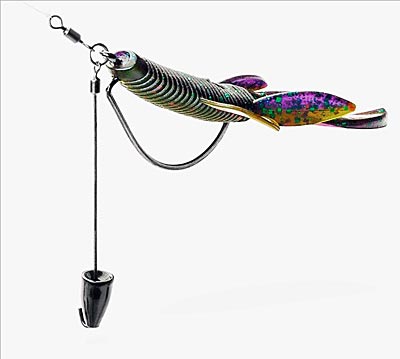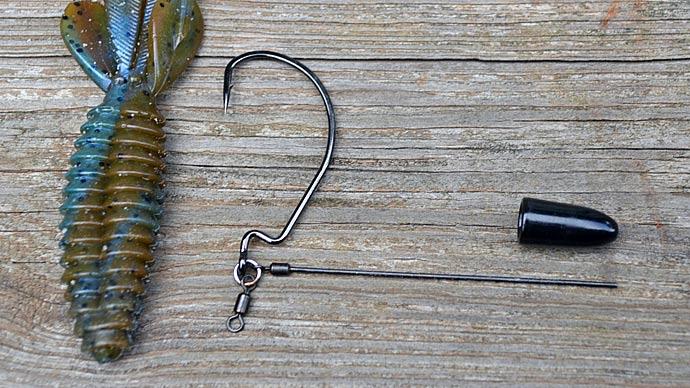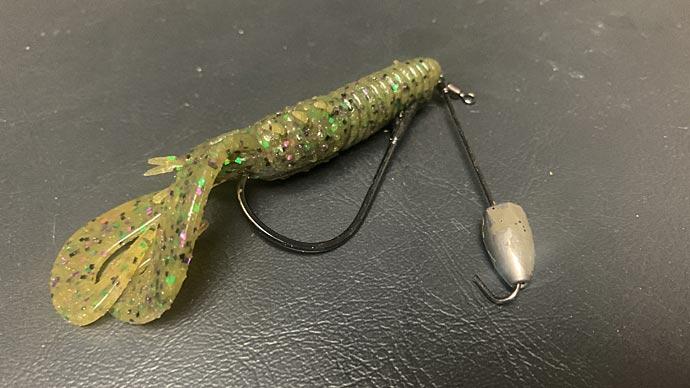
Fishermen are constantly making changes to baits – to give them more action, to make them easier to fish in certain cover or structure, to keep them at the correct depth, or to make their presentation look different from what the fish have been seeing. Often these changes are a reaction to heavily pressured waters or finicky bass. You can almost always catch bass on the old-school baits and rigs, but sometimes switching things up a bit can put much more fish in the boat. Here are four rigs you might want to try.
Chicken Rig
The Chicken Rig is a weedless version of the Neko Rig, opening up a world of new options. The Neko Rig is a wacky-rigged worm with a weight in the meaty end, and it works great on bass but not so great on cover. To turn a Neko Rig into a Chicken Rig, use a larger worm -- the 7” Strike King Rage Cut R Worm works great. You use a straight worm hook for this rig: a 4/0 or 5/0 for giant worms, 2/0 or 3/0 for smaller worms, or even a 1/0 if you use a slim finesse worm. The ReBarb that have a little holder on them look fantastic for this rig because they help keep the worm in place. VMC makes a great Neko hook that works well for this rig too.
Stick the point into the worm an inch or so behind the egg sack (on the tail side of the sack), thread the point through the egg sack at an angle, then push the point out and turn it around to Texas rig it. The eye will be inside the worm, which is why the ReBarb works so well. On smaller worms with shorter hooks, adjust where you insert the hook – you should have enough meat at the worm head below the point to insert a worm weight, nail, screw – whatever. Many guys like to use screws because there is more weight at the very end. You can buy mushroom-shaped specialty weights, too, if you don’t mind the price.
This rig is great anywhere you need a bait to be weedless, but you don’t have to limit yourself to grass and weeds. It’s killer on vertical structure, rip rap, boat docks, bluffs – you name it. The one caveat to this rig is that once you’re bit, the worm disintegrates, so you might go through many worms if you’re catching a lot of fish. But that’s a pretty good problem to have.

Tokyo Rig
The Tokyo Rig is perfect for punching, flipping, pitching, and any technique that means you want to get your bait to the bottom. A bonus is that you can quickly and easily change the weight without disturbing whatever plastic you have rigged on it. One of the things I like most about this bait is the way it lets you drag a bait across the bottom while at the same time the hook is up where it won’t snag on the rocks. It’s a lot like a dropshot rig with a short leader, but the weight stays on better, and the lure has much more freedom of movement.
The VMC Tokyo Rig employs a swivel at the front. On one end of the swivel, a small split-ring is attached. The split-ring holds both the hook and the sturdy wire on which the weight is held. The end of the wire is bent, so with a pair of needle nose pliers, you can unbend it and change the weight if you want to. The wire is long enough so that the hook and lure can swim along behind and above it when the weight is on the bottom. The hook is much less likely to get hung up, which is a problem I always have when dragging or hopping a big twin-tail grub or a jig on the bottom. Because of how it is designed, you have a straight shot at the hookset, but the weight doesn’t give big fish leverage to throw the hook. It’s genius.
Decoy Slide Weights

These Slide Weights aren’t a rig per se, but they are incredibly versatile. These weights slip onto a hook and can be kept in place by the rubber stoppers included with the weights. You can also position the stoppers to allow the weight to slide on the hook in any position you like. One of the best aspects of these weights is that they have a loop that allows you to attach a blade to the weight to turn any soft plastic into a reaction bait. Adding weight to the hook allows you to swim a bait more naturally than the weight in front.
To use them, push a rubber stopper on the hook – the first one goes on with the small end. The stoppers are egg-shaped, and you want the rounder end to face the weight. After pushing the first stopper on (you might have to use your thumbnail to get it past the point, but it’s smooth sailing), slip the weight on, then push another stopper on, this time with the rounder end first.
With these Decoy Slide Weights, you can rig a blade under any soft plastic to add flash and movement – ideal for a small fluke, swim bait, ribbon-tail worm, or anything you’d like to swim through the water column. These are also fantastic for adding thump to a big bait that you’re bouncing down a wall or rip rap – use a Colorado blade on a big Yamamoto twin-tail grub, Kreature, or PsychoDad. With a dark blade and a bulky craw or creature bait, this would also be the ideal nighttime or low-light swimming rig. Get some.
Jika Rig
The Jika Rig is very much like the Tokyo rig, but instead of a long wire with the weight on it, a cylindrical dropshot weight is attached to the eye of the hook via a split ring. You can rig these up yourself if you have the patience to attach split rings to hooks (use offset worm hooks), and you can use a snap swivel if you want to be able to change the weight quickly. You get fewer snags if you attach the weight to the split ring. My article on the Free Rig has tips on finding good cylindrical weights with round rings that make them easy to attach to the split ring or snap swivel.
These are great for craws and creatures and ideal for making a small swimbait dive nose down – perfect for bed fishing. Tube lures are fantastic on this rig – and when was the last time you fished a tube? Those little critters have such great movement in those tentacles that you should be fishing them on at least one of these rigs. Fish this rig almost like a drop shot rig. You could make it a bit bigger and fish bulky craws on it. It gives you a better feel for the bottom than a drop shot rig, so you know you have a fish on when you feel it go weightless.
Most of these rigs started in Japan or were invented by Japanese anglers, which catch bass with finesse methods. This winter, try one of these when the bite gets tough and see how it works for you. I’m pretty sure you’ll be pleasantly surprised.
BassResource may receive a portion of revenues if you make a purchase using a link above.




